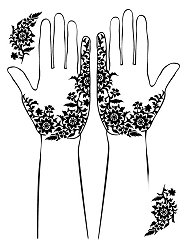 The Hennaed Guerrilla Fighters in Jerusalem, 70 CE also known as "The Pollutions of the Transvestite Leaders" Catherine Cartwright-Jones c 2004 Kent State University Simon the Zealot and his followers were outside Jerusalem’s city walls during a period of severe famine and political instability between 68 CE and 70 CE. Jerusalem was then a Roman colony, during a period of Roman governmental instability and corruption. Roman occupation was resented by many, and both Jews and early Christians fought against Roman rule, and several groups attempted guerrilla attacks to drive out the Romans. Some of Simon's fighters entered Jerusalem, got into the homes of some wealthy citizens, murdered the occupants and ate as much of their food as they could to regain their strength. Then, the guerrilla warriors took the women's jewels, garments, kohl, perfumes, and hennaed their hands. These guerrillas put on the rich women’s garments, their henna and kohl, their veils and jewelry so they could pass as women. Then, posing as sex workers, they went easily go throughout the city, flirting, swaying, behaving seductively, so their enemies would approach them for sex. One by one, the hennaed guerrilla fighters and hopeful clients went off to find some privacy. There is no specific mention of precisely what the guerrilla fighters were doing with their hennaed left hands as they emulated female sex workers, but they used their right hands to draw their the swords from under stolen beautiful robes, and slaughtered their customers. Those who tried to escape the attack by fleeing the city gates ran straight into Simon’s forces and were killed. This and corroborating accounts support henna use by women in Jerusalem during the Roman period, certainly by sex workers and wealthy women. One may assume that the guerrilla fighters had their faces at least partially veiled with their women's robes to disguise their masculine faces, revealing kohled eyes, hennaed hands and jewelery to pass as women. Editor's note: Unguentum and Ointments Many of the forumlae of Latin "unguentum", translated as the word "ointments" in English, have henna as a primary ingredient. The characteristics of "unguentum" include "softening of the skin", "perfuming skin", and "tinting skin". Therefore, cautiously, when there is other evidence corroborating the interpretation of "unguentum" as henna, I support the translation of "unguentum" as henna. Henna softens the skin, especially soles and palms. Henna perfumes the skin (there is a noticeable odor which lingers after henna application). Henna does tint the skin. The regions where "unguentum" originates are areas where henna grows, and artifact evidence supports henna use. See: Regale Unguentum Web resources for Josephus's account of this incident: http://www.preteristarchive.com/JewishWars/jo-4-9-10.html http://www.preteristarchive.com/JewishWars/ http://www.publicbookshelf.com/public_html/Outline_of_Great_Books_Volume_I/templejer_cg.html  Pattern from Alex Morgan's upcoming book, "Warrior" patterns adapted from the weapons of war Click on image for this and more patterns from her book! Field, Henry Body-Marking in Southwestern Asia Papers of the Peabody Museum of Archaeology and Ethnology, Harvard University Vol. XLV, No 1 Peabody Museum, Cambridge Massachusetts, USA Josephus, Wars of the Jews, IV, 9 and 10 Return to The Encyclopedia of Henna Index Return to the War Index Can't find what you're looking for? Try: The Henna Page Main Index http://www.hennapage.com/henna/mainindex.html *"Henna,
the
Joyous Body Art"
the Encyclopedia of Henna Catherine Cartwright-Jones c 2000 registered with the US Library of Congress TXu 952-968 |
